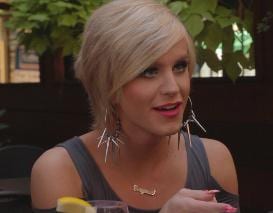Like much of reality television there’s a vast difference between what The Avenue proposes to be and what it actually is. Now in its second season, the Toronto-centric web series follows four 20-somethings navigating life in the big city.
Co-creators Scott Fisher and Jacob Morris (still Ryerson students during Season 1) claim they are documenting the everyday life of Gregory Gorgeous (a minor YouTube celebrity who makes instructional makeup videos). They follow the high-heeled high-femme and his pals Arta (tough-as-nails editor of Défilé magazine), Rachel (hard-drinking party girl) and Claire (doe-eyed sweetie) as they shop, party and gossip.
The whole thing is oh-so Toronto; everyone’s always “very busy” though they almost never actually do anything. Dialogue often centres on whether someone was “rude” or if a future meeting will be “awkward.”
The show’s premise as unscripted “reality” has more holes than a mesh tank top. For starters, characters can’t maintain their plot points from one second to the next. Arta initially works for Défilé (a magazine that doesn’t actually exist), then later works for Lifestyler (which does). Gregory says he moved to Toronto to take his career “to the next level” after he “was able to make a name for [him]self in the fashion and beauty industry” (presumably while living with his parents in Mississauga?). In the same breath he confesses he’s actually here for a guy, the much-talked-about but never-seen “Dan.”
The script is rife with implausibility. Secondary characters “randomly” stumble into conversations with the stars, apparently unaware of the cameras and already wearing their microphones. In the first season, Gregory’s a fashion student at George Brown who can afford an apartment in Yorkville (because that’s the coolest neighbourhood to live in?). By Season 2 he’s shacked up in a Rosedale mansion, paid for (we’re to believe) by his numerous “product endorsement” contracts.
In fairness, kids weaned on Sex and the City deserve some slack. Even 40-somethings bought Carrie Bradshaw’s big-city fairy tale of infinite cash for Manolo Blahnik pumps and Hell’s Kitchen lunches, despite never apparently working. The Avenue’s characters show us the lives they aspire to, not what they actually live. And who can blame them? If I’d reimagined my own life as a TV show fresh from my parents’ place in the mid-’90s, I’d have lived in a sprawling warehouse off Queen West and worked at Siren goth boutique (neither of which actually happened).
Despite its naive sloppiness, The Avenue is popular, racking up a healthy viewership (though not the “millions” its publicity team claims). It’s been covered in Toronto Life and The Globe and Mail, even though it’s largely the butt of jokes. While it’s a vapid guilty pleasure for 30-somethings, it’s also a potential source of inspiration for queer suburban youth. Gregory’s aspirational “Born This Way” message of gender-flexible fabulosity suggests their dreams of self-expression can come true if they just make it south of Eglinton.
The show’s accidental genius may be its insight into the lives of Millennials, the generation that learned to type by instant messaging, to socialize on social media, and to gain semi-fame making videos alone in their bedrooms. Season 2 opens with Gregory saying he’s trying to “focus on what’s real.” Should we be surprised the Facebook generation’s version of focusing on what’s real means creating an alternate reality that better matches the life they want?


 Why you can trust Xtra
Why you can trust Xtra


